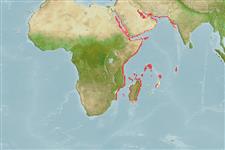Common names from other countries
Classification / Names / Names
Nama-nama umum | Sinonim (persamaan) | Catalog of Fishes (gen., sp.) | ITIS | CoL | WoRMS
Environment: milieu / climate zone / depth range / distribution range
Ekologi
Berasosiasi dengan karang; kisaran kedalaman 1 - 12 m (Ref. 98471). Tropical; 30°N - 28°S, 35°E - 72°E (Ref. 846)
Endemic to Persian Gulf.
Length at first maturity / Size / Weight / umur
Maturity: Lm ? range ? - ? cm
Upper reef slopes and lagoons (Ref. 846). Ubiquitous, found mixed with Acropora clathrata, most common at depths of 3 to 5 m (Ref. 108326).
Life cycle and mating behavior
Kematangan | Reproduksi, perkembang biakan | Pemijahan | telur-telur | Fecundity | Larva
Members of the class Anthozoa are either gonochoric or hermaphroditic. Mature gametes are shed into the coelenteron and spawned through the mouth. Life cycle: The zygote develops into a planktonic planula larva. Metamorphosis begins with early morphogenesis of tentacles, septa and pharynx before larval settlement on the aboral end.
rujukan utama
Acuan | Koordinator | mitra
Wallace, C.C. 1999. (Ref. 86439)
Status IUCN Red List (Ref. 130435)
status CITES (Ref. 108899)
Not Evaluated
penggunaan manusia
| FishSource |
Alat, peralatan
informasi lanjut
Umur / SaizPertumbuhanpanjang-beratpanjang-panjangMorfologiLarvaKelimpahan
Sumber internet
Estimates based on models
Preferred temperature
(Ref.
115969): 25.4 - 29.1, mean 27.3 (based on 686 cells).
kategori harga
Unknown.
